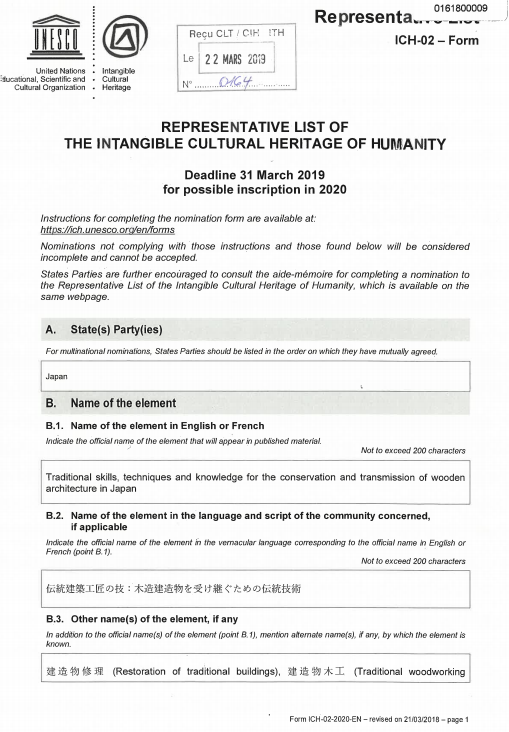文化庁は、2019/3/22付けで、「伝統建築工匠の技」をユネスコ無形文化遺産に再申請をしており、2020年12月初旬には、登録が発表される予定です。

↑申請書原文の表紙
この申請書のリンク先 https://ich.unesco.org/doc/src/43847-EN.pdf
【要約の部分】
The nomination consists of 17 traditional skills and techniques indispensable for conserving and transmitting wooden architecture in Japan. These skills and techniques are practiced by craftspersons who transmit them from generation to generation.
The vast knowledge regarding wood and other natural materials that these craftspersons possess comes from Japan’s natural environment. Roughly 70% of Japan is forested. Therefore,
wood and natural materials have been part of their lives since ancient times; they have made tools for daily use and built houses and other structures out of wood. They also acquired knowledge to restore these wooden structures, which begin decaying from the moment they are built because most of Japan has a hot and humid climate. Under these environmental conditions, it is not only the techniques for building new structures but also those for restoring existing ones that have played crucial roles in life with wooden structures. The damaged parts must be repaired every few years or decades. These skills and techniques require not only fine manual work, but also the knowledge about raw materials necessary for conservation and restoration.
Many historic wooden structures that have been conserved and recreated by these traditional skills and techniques continue to provide cultural symbols for present-day Japanese. For example, the oldest surviving wooden structure in the world, Horyu-ji temple (built in the early 7th century), is still visited by many. Such wooden cultural heritage, including their interior parts, has been a cultural and spiritual basis of the Japanese people.
【翻訳】(当会での翻訳となりますので、文化庁が発表したものではありませんことをご了承ください)
この推薦候補は、日本の木造建築の保存・継承に欠かせない17の伝統的な技術・技能で構成されています。これらの技術・技能は、それらを代々伝承してきた職人によって実践されています。
職人たちが持つ、木やその他の自然素材に関する膨大な知識は、日本の自然環境に由来しています。日本の国土の約7割は森林で覆われています。そのため、古来より木や自然素材は日本人の生活の一部であり、彼らは生活に必要な道具や、家、その他の建造物を木で作ってきました。また、日本の多くは高温多湿の気候であるため、建てたらすぐに腐り始めてしまう木造建築物を修復する知識も彼らは身につけてきました。このような環境条件の中、新しい建築物を建てる技術だけでなく、既存の建築物を修復する技術もまた、木造建築物と共に生きる生活において重要な役割を果たしてきました。破損した部分は数年、または数十年ごとに補修しなければなりません。これらの技術や技能は、洗練された手仕事の技だけでなく、保存修復に必要な原材料に関する知識も必要としています。
これらの伝統的な技術と、技術によって保存・再生された歴史的な木造建築物の多くは、現代の日本人にとって文化的なシンボルとなっています。例えば、現存する世界最古の木造建築物である法隆寺(7世紀初頭建立)は、今でも多くの人々が訪れています。このような木造文化遺産は、その内部を含め、日本人の文化的・精神的基盤であり続けてきました。